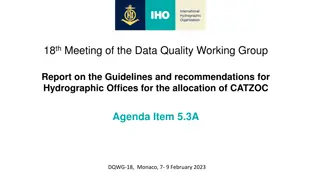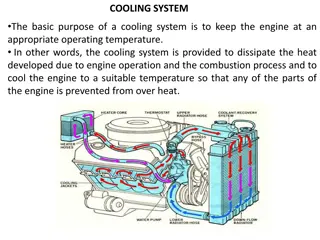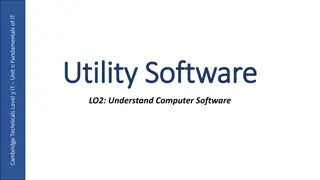Understanding Mechanisation in Offices: Objectives, Advantages, and Disadvantages
Mechanisation in office work aims to enhance efficiency, reduce monotony, and improve accuracy by introducing machines and equipment. The objectives of office mechanisation include saving labour and time, ensuring accuracy, and reducing errors. Advantages include quality work output, low operating costs, high efficiency, accuracy improvement, monotony relief, and standardisation of work procedures. Despite the benefits, disadvantages such as initial costs, potential job displacement, and technical issues should also be considered.
Download Presentation

Please find below an Image/Link to download the presentation.
The content on the website is provided AS IS for your information and personal use only. It may not be sold, licensed, or shared on other websites without obtaining consent from the author. Download presentation by click this link. If you encounter any issues during the download, it is possible that the publisher has removed the file from their server.
E N D
Presentation Transcript
Mechanisation Objectives, Advantages and disadvantages Presented by Dr. B. N. Shinde Assistant Professor Department of Commerce Deogiri College, Aurangabad
Objectives of Office Mechanization Office work is brainwork and involves repetitive in character. The repetitive nature of office work creates monotony. The relieve of office workers from monotony can be done by providing comfortable sitting arrangement, working conditions and suitable furniture and machines. Office machines and equipments have become an integral part of a modern office. Mechanization means the process by which machines and equipments are introduced with a view to speeding up the administrative process. Office cost is reduced substantially by the introduction of machines. The introduction of mechanization leads to saving in time and reduced operational costs. The following are the broad objectives of mechanization.
Continue (a) It enables in saving of labour and as such, office machines are regarded as labour-saving devices. (b) Mechanization helps in saving of time, which results in establishing the efficiency of the organization.
Continue (c) It ensures accuracy in work of operation. (d) The chances of errors and frauds are reduced to minimum because of introduction of machines. (e) It helps in reduction of monotony in work.
Advantages of Mechanization in office 1. Quality of Work The work performed with the help of machine is generally more neat and legible than the work completed by hand. Therefore, the using of machines ensures the quality of work. 2. Low Operating Costs Only labor and time saving machines are used in an office. Therefore, the wage bill may be reduced and produce more work. 3. High Efficiency All the work can be performed with short period. In this way, the machines are utilized to increase the efficiency of operations.
Continue 4. Accuracy Human beings may commit more number of errors knowingly and unknowingly. However, the mechanization prevents such clerical errors and omissions. It improves accuracy of work, especially in accounting, computations, and statistical calculations. 5. Relieves Monotony Using machines and equipment can reduce boring and time consuming. The monotony of doing a work is avoided in this way. 6. Standardization of Work The work of office routines and procedures can be standardized with the help of mechanization facilities. The standardization leads to uniformity and better coordination of work.
Continue 7. Effective Control More information can be supplied quickly to management. The management also exercises effective control. Thus, the chances of fraud are minimized. 8. Create Goodwill The improved efficiency leads to greater profitability and creates goodwill of the organization in the minds of suppliers and customers who are dealing with the organization. 9. Quality Decision Mechanization supplies adequate information to the management without any delay. This process facilitates the management to take quality decision. 10. Covering More Work A single machine can do the work of two or three employees. Hence, the employees may be deputed to do some other work. In this way, more work can be covered through the process of mechanization.
Disadvantages of Mechanization in office 1. Heavy Investment The initial cost of a machine is high. If number of machines purchased is greater, there is a need of making heavy investment by the management. 2. Waste An idle machine is a waste. This wastage is greater, if the machine is costly. 3. Retrenchment Problem Adoption of certain machines will lead to retrenchment of some employees. If so, the management will face such problem. 4. No Trained Staff The purchasing and utilization of machines require skilled employees for operation. If trained or skilled employees are not available, the machines cannot utilize properly.
Continue 5. Increase Cost of Operation Sometimes new staff may be appointed to operate the machines. If so, the salary bill of an organization will be increased. Thus, there is an increase in cost of operation. 6. No Power No Work Most of the machines are operated with the help of power. There is no possibility of doing a work during the period of power cut or power failure. 7. Break Down of Machine The machines may be break down over a period. There is stagnation in the performance of work if machines are break down.
Continue 8. Set Right the Machines The outsiders are invited to set right the machines if they are break down. The outsiders come to the business office according to their convenience. No work is performed until the machine is set right. 9. Affect Urgent Work The employees will be lazy after the mechanization of office work. The performance of urgent work is affected during the period of break down of machines. 10. Reduces Profit There is no charging of depreciation before mechanization. After mechanization, depreciation charges are high. This will reduce the profit.
Continue 11. Obsolescence Some machines may become obsolete within a short period. 12. Slaves of Machines Human beings may become slaves to the machines. Unless great care is taken, the machines will become more important than the work it produces. 13. Noise and Space Problems The operation of machines may create noise. If adequate space is not available, it is very difficult to use the machines. 14. Dislocation of Work A single person can be appointed to operate the machines. If he/she takes leave, there is a dislocation of work. Thus, two operators are employed even though one would be enough.
Factors affecting office mechanization Need for a particular machine or equipment s can be determined with reference to the following factors: 1. Available Alternative: Can a work be done by any alternative method using a simple mechanical procedure and can it be done efficiently? This aspect of planning analysis holds importance before deciding to shell out the money to buy a machine. 2. Simplification of the Work and Its Procedure: There may be certain jobs which are complicated, non compact and a long dreary process may be involved in completing the office task. Looking into it one might feel the importance and necessity of a machine to be installed in the office. If a procedure can be evolved to eliminate these hazards, and if a process of simplification is obtained, then the need for a particular machine may disappear.
Continue 3. Peak Load: If a machine has to be purchased only to sort out the load of work during its peak time of business, then it is not advisable to buy such machine at all.
Office Machines and Equipment? The term officeequipment includes any long-term asset that is used to conduct administrative or office-related tasks. So, the category is very broad. In fact, it's often easier for accounting and tax purposes to consider what is excluded from office equipment. Notably, office supplies and office furniture are typically categorized and tracked separately from office equipment. Office supplies include materials that you would normally expect to consume and replace more regularly. Examples would include items such as letterhead and other stationery, business cards and the like. Desks, desk chairs, guest or client seating, tables and other furniture are included in the office furniture category.
Continue Computer Equipment Modern offices invest substantially in computer equipment because staying connected both internally and to the world is usually a mission-critical need. Most offices will need multiple desktop and laptop computers, as well as printers to create hard copies of letters, agreements and other documents. Offices may also need to turn hard copies of documents into digital files. Scanners and cables to connect the device to a computer are required for such tasks. Digital cameras, projectors for presentations and image printers may also be required.
Continue Communications Equipment Business offices depend heavily on their ability to communicate with other departments or locations in the same business, as well as other businesses, clients and vendors. Telephones also help connect office workers with each other internally, which helps increase productivity by cutting down on walking time to relay quick messages. Interoffice communications also help foster a more professional image to office visitors. While fax machines are used less in business offices than in the past, some businesses still require their use for transmittal of hard-copy documents that cannot be scanned. This is more commonly found in offices that handle secure, sensitive or confidential paper records, such as law firms and medical offices.
Continue If an office requires a substantial amount of document preparation, especially correspondence, it may be prudent to invest in dictation equipment in order to make it easier for administrative assistants to process and create hard copies of letters and other dictated documents. Other communications equipment a business office may need include cordless telephones, answering machines, Bluetooth headsets, cellular devices or smart phones, tape recorders, video recording and display equipment and televisions or display monitors.
Continue General Office Equipment Other equipment may also be required by offices. File cabinets are important for maintaining copies of documents that must be kept on the premises, either for safekeeping or easy reference. For the same reason, a fireproof safe can secure valuables and sensitive original documents. Some pieces of equipment are so ubiquitous that almost all offices will need them and make regular use of them. For example, the photocopier helps offices create necessary duplicates of documents that the business must create for partners and clients, such as correspondence and agreements or contracts. Paper shredders are also necessary in order to properly dispose of sensitive, proprietary or otherwise confidential information in a secure manner. Offices may also need other general equipment such as postage meters to process outgoing mail, a label-maker for storage needs and whiteboards for planning and strategy sessions.

















































